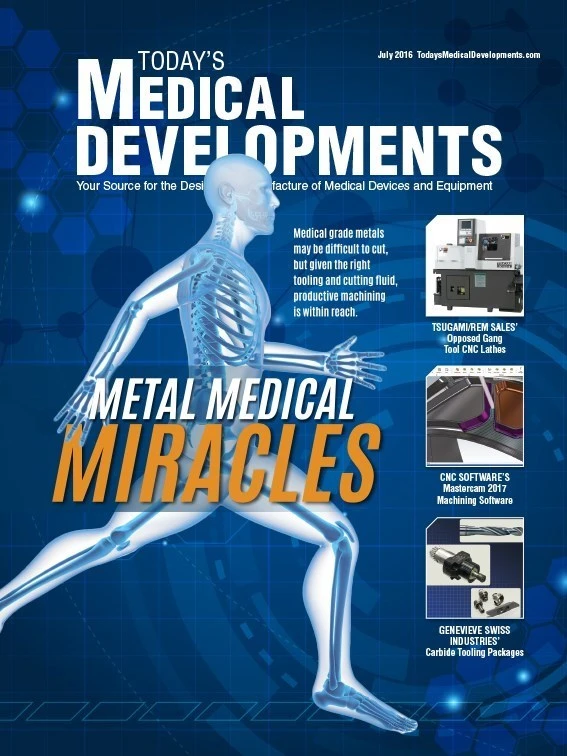
In a proof-of-concept experiment, Australian researchers have used a handheld 3D printing pen to draw human stem cells in freeform patterns with high survival rates. The device was developed in collaboration with ARC Centre of Excellence for Electromaterials Science (ACES) researchers and orthopedic surgeons at St. Vincent’s Hospital, Melbourne, to allow surgeons to sculpt customized cartilage implants during surgery.
The pen delivers a cell-survival rate of more than 97%. A hydrogel bio-ink carries and supports living human stem cells, and a low-powered light source solidifies the ink. Bioprinters have the potential to revolutionize tissue engineering, as they can be used to print cells, layer-by-layer, building artificial tissues for implantation.
In some applications, such as cartilage repair, the exact geometry of an implant cannot be precisely known prior to surgery, making it difficult to prepare an artificial cartilage implant. The pen treats defects by filling them with custom scaffolds.
“The development of this type of technology is only possible with interactions between scientists and clinicians to identify the problem and scientists to develop a solution,” says Professor Peter Choong, director of orthopedics at St. Vincent’s Hospital.
The team developed the pen with surgical constraints in mind and fabricated it using 3D-printed, medical-grade plastic and titanium. The device is small, lightweight, ergonomic, and sterilizable. A low-powered light source is fixed to the device and solidifies the inks during dispensing.
“The biopen project highlights both the challenges and exciting opportunities in multidisciplinary research,” says Professor Gordon Wallace, ACES director. “When we get it right, we can make extraordinary progress at a rapid rate.” www.electromaterials.edu.au; svhm.org.au
Commercial CLIP-based additive manufacturing

The M1 commercial 3D printer uses continuous liquid interface production (CLIP) technology and engineering-grade materials. The printer offers high-resolution parts with the engineering-grade mechanical properties and surface finish required for functional prototyping and production-quality parts. Internet-connected and data-rich, the M1 collects more than 1 million process-control data points per day, allowing remote diagnostics, assistance with print optimization, and improved print quality. The M1 has seven proprietary resins, enabling the use of complex chemistries to create parts with a range of mechanical properties. www.carbon3D.com
Fathom and Nano Dimension introduce 3D printer

Fathom and Nano Dimension willcollaborate on the introduction of the DragonFly 2020 3D printer to Silicon Valley and the greater West Coast area.
“Both companies share the same vision of changing the way products are designed and manufactured,” says Michelle Mihevc, Fathom principal and co-founder. “Nano Dimension is leading the way in the 3D printed electronics space.”
Mihevc and her partner Rich Stump started Fathom in 2008.
“Fathom will help bring us even closer to our key customers because it is well-known as one of the most creative and best performing 3D printing services companies in the country,” says Simon Fried, Nano Dimension CBO. www.nano-di.com; www.studiofathom.com
High-strength PETG based 3D material

A high strength polyethylene terephthalate glycol-modified based material, guidel!ne, from taulman3D offers high temperature printing capabilities and addresses the difficulty of printing small features of some parts due to thermal build-up. The material is also a starting point for developers wishing to obtain FDA/CE certification for a device, knowing that the raw material is listed with the FDA and has passed FDA testing.
Sold as a raw material, guidel!ne is extruded in a way that keeps contaminates out of the soft material during cooling, where contaminates and bacteria could be embedded. In addition, pH and ORP levels are monitored and adjusted to maintain acceptable levels.
Information provided to the guidel!ne user will be in sync with the FDA’s “Technical Considerations for Additive Manufactured Devices Draft Guidance for Industry and Food and Drug Administration Staff, Section C, Material Controls.” While certificate of authenticity will be the responsibility of the end user, taulman3D will provide information to support such efforts. www.taulman3d.com

Explore the July 2016 Issue
Check out more from this issue and find your next story to read.
Latest from Today's Medical Developments
- Arcline to sell Medical Manufacturing Technologies to Perimeter Solutions
- Decline in German machine tool orders bottoming out
- Analysis, trends, and forecasts for the future of additive manufacturing
- BlueForge Alliance Webinar Series Part III: Integrate Nationally, Catalyze Locally
- Robot orders accelerate in Q3
- Pro Shrink TubeChiller makes shrink-fit tool holding safer, easier
- Revolutionizing biocompatibility: The role of amnion in next-generation medical devices
- #56 Lunch + Learn Podcast with Techman Robot + AMET Inc.





